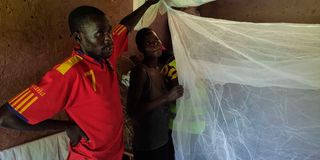Malaria-endemic counties to receive 15.3 million bed nets from US, Global Fund

What you need to know:
- The Health Ministry also said the 2023/2024 mass net distribution campaign was launched in Homa Bay County on November 15, 2023, with 830,862 nets distributed, covering 91 percent of registered households.
- While urging the beneficiaries to use the nets correctly and consistently to protect themselves from mosquito bites, the primary mode of transmission of malaria, the PS Muthoni noted that long-lasting insecticidal nets (LLINs) are a highly effective tool in malaria prevention and control programs.
The Ministry of Health (MoH), in partnership with the US President's Malaria Initiative and the Global Fund, will distribute 15.3 million bed nets this year to 22 high-burden counties grouped into five clusters.
According to the Ministry of Health, cluster one beneficiaries include Kisumu, Siaya, Busia, Migori, Kisii and Nyamira counties; cluster two includes Lamu, Kilifi, Tana River, Kwale, Taita Taveta, and Mombasa; while cluster three consists of Bungoma, Kakamega, Vihiga and Homa Bay.
Cluster four comprises of West Pokot, Turkana and Trans Nzoia while Cluster Five is made up of Narok, Baringo and Kirinyaga.
Mass distribution campaign
The Health Ministry also said the 2023/2024 mass net distribution campaign was launched in Homa Bay County on November 15, 2023, with 830,862 nets distributed, covering 91 percent of registered households.
"Distribution in Kisii County will begin on January 24, 2024, where 941,368 nets will be issued, and distribution in Nyamira County will begin on January 31, 2024, where 449,974 nets will be issued. The Ministry of State has approached this campaign with a different strategy, including digitization of the entire process to improve efficiency, effectiveness and accountability at all levels," Principal Secretary for Public Health Mary Muthoni said Tuesday.
Malaria prevention and control programs
While urging the beneficiaries to use the nets correctly and consistently to protect themselves from mosquito bites, the primary mode of transmission of malaria, the PS Muthoni noted that long-lasting insecticidal nets (LLINs) are a highly effective tool in malaria prevention and control programs.
"To improve coverage and use of LLINs for malaria vector control, Kenya has adopted the World Health Organization (WHO) recommendation to conduct mass LLIN distribution campaigns every three years," she said.
The first mass distribution campaign for universal coverage took place in 2006, when 3.4 million nets were distributed, integrated with measles vaccination. This was followed by the 2011-12 campaign, which distributed 10.6 million LLINs to populations in malaria endemic and epidemic regions.
“Replacement distribution in 2014/ 15 included 13.1 million nets, followed by distribution of 15.1 million nets in 2017/2018 to protect vulnerable populations in the same regions," the PS added, recalling that the 2020/21 campaign was conducted amid the challenges of Covid-19, with distribution of approximately 16.2 million nets in 27 districts.
"The distribution of LLINs to households has shown tremendous progress in the fight against malaria, with a significant reduction in malaria prevalence from eight percent to six percent nationally according to the Kenya Malaria Indicator Survey 2015 and 2020," she said.
Global and public health concern
Therefore, according to PS Muthoni, in order to sustain the gains made and further contribute to effective malaria vector control in the country, the Ministry of Foreign Affairs has embarked on a relentless journey in the fight against malaria, recognising it as a global and local public health concern.
"In Kenya, malaria has placed a heavy burden on the population, with approximately 6.7 million clinical cases and 4,000 deaths reported in 2022. Children under the age of five and pregnant mothers continue to bear the brunt of this preventable disease," she said.
The Ministry of Health also announced that this week, the National Steering Committee and the National Malaria Control Program have started preparing the next six districts for distribution.
"This campaign, which is scheduled to run from January 22 to February 3, 2024, will cover Kisumu, Siaya, Migori (in the Lake endemic region), Kwale, Mombasa and Taita Taveta (in the Coast endemic region) using lessons learned from past experiences.
Universal Health Coverage
The exercise commenced on Monday, January 22 with data validation, county and sub-county sensitization, training of health workers and training of community health workers (CHPs) and village elders," PS Muthoni announced, adding that this will be followed by validation and social mobilization for household registration in line with the government's bottom-up economic transformation agenda aimed at empowering people at the household level to own and control determinants of their health matters and health seeking behavior as a key pillar of Kenya's Universal Health Coverage.
The PS further disclosed that Taita Taveta will receive 262,865 bed nets, Kwale will receive 668,779, Mombasa will receive 932,284, Siava will receive 738,008, Kisumu will receive 858,658 nets, while Migori will receive 829,507 nets, making a total of 4,290,101 nets earmarked for distribution, with allocations projected from the 2019 census.
"After the distribution of nets in these six counties, we will continue with the distribution in ten more counties in March and April this year until all the targeted population get the LLINs they need.
ALL stakeholders, teams, committees, national and county leadership, influencers and communities are called upon to focus on quality and timely preparations including registration ahead of the 2023/24 distribution campaign which we expect to conclude by the end of April 2024," Ps Muthoni announced.





